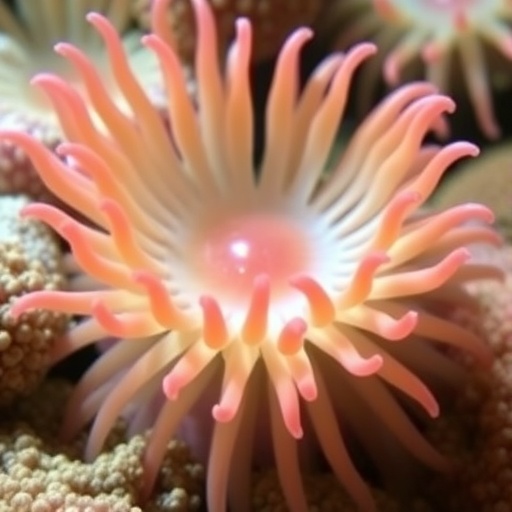In a groundbreaking study, researchers have significantly advanced our understanding of the biology of the starlet anemone, Nematostella vectensis, a model organism prominent in developmental biology and genetics. This remarkable creature, with its powerful regenerative capabilities and simple body plan, has long captivated scientists seeking to uncover the mysteries of cellular and tissue development. In their new research publication in Frontiers in Zoology, Angie G. Cole and colleagues present an updated single cell reference atlas, showcasing the unprecedented diversity and complexity of cellular types present in this organism.
This reference atlas represents a vital resource for the scientific community, particularly for those working in fields such as marine biology, evolutionary developmental biology, and ecological genomics. The study is grounded in the necessity for high-resolution cellular data to serve as benchmarks for the vast array of studies that will explore the biological and ecological facets of Nematostella vectensis. By mapping out this organism’s cellular composition in fine detail, researchers are poised to draw connections between cellular function and developmental processes across the animal kingdom.
One of the standout features of Nematostella vectensis is its relatively simple anatomy compared to more complex organisms. It exhibits a body plan comprised primarily of two layers of epithelial cells, which encompass its gastrodermis and epidermis. This simplicity allows researchers to delve deeply into cellular interactions and the genetic regulation of development without the complications inherent in examining more advanced organisms. The new atlas meticulously categorizes the various cell types, unveiling novel insights into their roles and relationships within the organism.
Furthermore, the updated atlas addresses prior gaps in knowledge regarding specific cell types previously unidentified in the starlet anemone. The researchers employed state-of-the-art single-cell RNA sequencing techniques to ascertain the expression profiles of individual cells. This revolutionary approach allowed them to generate a comprehensive inventory of gene expression patterns associated with distinct cell types, bridging prior data deficiencies and providing a foundation for future studies.
In addition to offering a comprehensive view of cellular diversity, the atlas establishes essential connections to evolutionary biology. Nematostella vectensis has often been used as a model to illuminate the evolutionary origins of multicellularity. Understanding its cellular framework sheds light on the evolutionary processes that have shaped complex life forms over millions of years. This research connects cellular data to the overarching narratives of evolutionary biology and can significantly influence future explorations of other marine organisms.
The implications of this study extend beyond biology and evolutionary theory; they also touch on ecological resilience and adaptability. Knowing how Nematostella vectensis responds at the cellular level to environmental changes or stressors promises to inform broader ecological models. For instance, the cellular responses mapped in this research may yield valuable insights into how marine organisms respond to climate change, pollution, and habitat disruption. Insights gathered from such studies can help inform conservation efforts and management practices aimed at safeguarding marine ecosystems.
Additionally, this single cell reference atlas serves as a model for future studies in related fields. The methodologies developed and refined during this research are applicable to the study of other organisms, especially other representatives of the cnidarian phylum. By standardizing approaches to cell-type identification and gene expression studies, researchers can create interconnected databases that are invaluable for comparative studies across various species. The extrapolation of this technique fosters a broader understanding of cellular biology, influencing multiple domains in the life sciences.
The intricate process by which this atlas was synthesized involved a collaborative effort amongst a multidisciplinary research team. Comprising experts from various fields—genetics, marine biology, and computational biology—their combined expertise allowed for a holistic approach to the study. This collaboration underpins the importance of interdisciplinary research in addressing complex questions and developing comprehensive resources that serve broader scientific goals.
Moreover, the publication is set to inspire a wave of new research focused specifically on cnidarians and other marine invertebrates. With evolving technologies and analytical tools, the next generation of biologists and ecologists are equipped with resources that allow for exploratory research that was previously constrained by a lack of foundational knowledge. The starlet anemone’s unique characteristics position it as an ideal subject for investigating both basic biological mechanisms and applied ecological research.
As the scientific community begins to digest the data presented in this pivotal paper, we can anticipate a proliferation of research endeavors that reference this innovative atlas. The reliable benchmarks established within serve not only present studies but also pave pathways for future inquiries. Researchers globally will leverage this knowledge as they embark on studies that offer further insights into cellular dynamics, regeneration, and evolutionary transitions.
In conclusion, the updated single cell reference atlas for Nematostella vectensis marks a significant leap forward in marine biological research. It expands our understanding of the cellular architecture within this key model organism and provides essential data that can be drawn upon for numerous future studies across various biological disciplines. Through this illuminating research, Cole and colleagues not only enhance the scientific toolkit available for investigating the complexities of life but also solidify Nematostella vectensis as a quintessential organism for unraveling the intricate ties between structure, function, and evolution in the natural world.
The promising findings and methodologies presented pave the way for a deeper exploration into the biology of marine organisms and hold incredible potential for future research endeavors, making this a landmark contribution to the body of knowledge in biological sciences.
Subject of Research: The updated single-cell reference atlas of the starlet anemone Nematostella vectensis
Article Title: Updated single cell reference atlas for the starlet anemone Nematostella vectensis
Article References:
Cole, A.G., Steger, J., Hagauer, J. et al. Updated single cell reference atlas for the starlet anemone Nematostella vectensis. Front Zool 21, 8 (2024). https://doi.org/10.1186/s12983-024-00529-z
Image Credits: AI Generated
DOI: 10.1186/s12983-024-00529-z
Keywords: single-cell reference atlas, Nematostella vectensis, cellular biology, marine biology, developmental biology, evolutionary biology, ecological genomics, gene expression, cnidarians, marine invertebrates




